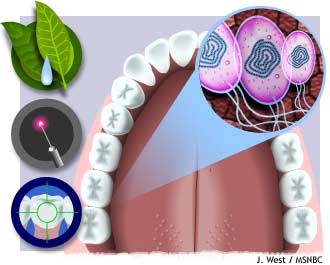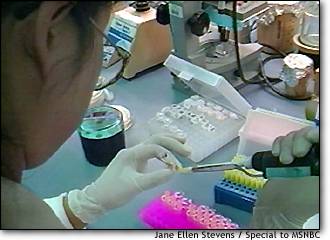 MORE THAN **25** YEARS OF DENTAL EXCELLENCE | | ISO 9001:2000 CERTIFIED |
A2 AASHIRWAD, II CROSS LANE, LOKHANDWALA COMPLEX, ANDHERI (WEST), MUMBAI 400053, INDIA | 2632 8682 / 3082 7053 / 98193 63215 |
 MORE THAN **25** YEARS OF DENTAL EXCELLENCE | | ISO 9001:2000 CERTIFIED |
A2 AASHIRWAD, II CROSS LANE, LOKHANDWALA COMPLEX, ANDHERI (WEST), MUMBAI 400053, INDIA | 2632 8682 / 3082 7053 / 98193 63215 |
|
DENTAL NEWS ARCHIVES 028 |
 |
Dr. Page Caufield discusses research on mothers and babies that may lead to new methods of preventing cavities. |
| By Jane Ellen
Stevens SPECIAL TO MSNBC |
| March 20,2000 — The next time you plant a big, wet juicy one on the lips of your significant other, think about this: In each of your very kissable mouths lives more than 500 species of bacteria. Billions and billions of them. They grow on every slimy surface, dark nook and inviting cranny. By understanding the complex relationships among the inhabitants of this tiny jungle ecosystem, researchers plan to usher in a new era of pain-free dentistry. No more drills. No more fillings. |
IN ESSENCE, each of us walks around with our own miniature rain forest that’s a perfect environment for bacteria. The mouth has an average temperature of 95 degrees Fahrenheit. Its humidity hovers at 100 percent. It’s stoked regularly with sugar and simple carbohydrates, manna from bacteria heaven. In one mouth, the number of bacteria can easily exceed the numbers of people who live on the entire planet, according to Dr. Sigmund Socransky, a researcher who’s been studying these microscopic critters for decades at the Forsyth Institute in Boston. In a recently brushed mouth, he said, 1,000 to 100,000 bacteria live on each tooth. In a dirty mouth, however, each tooth harbors 100 million to one billion bacteria. The good news is that most are friendly. In exchange for living in this tropical paradise, the hundreds of species of beneficial bacteria help fend off disease-producing bacteria that attempt to invade the mouth from the outside world. It’s only about a dozen species of bacteria and yeast that can cause infections in the teeth and gums. WAR ON CAVITIES |
A new world of dental research has bloomed around oral ecology. Investigators are hoping to devise ways to spot cavities before a dentist can see them, induce teeth to repair themselves, make diseased gums grow healthy tissue, put antibodies to disease-causing bacteria into plants that we’d eat, and seal mothers’ teeth so that they don’t transmit cavity-causing bacteria to their babies. The simple fact is that we’ve gone about as far as we can with brushing, flossing and adding cavity-fighting fluoride to water supplies, toothpaste and mouthwashes. Fifty-one percent of American kids under 12 don’t have cavities. But of the 49 percent that do, many have disease that’s difficult to control, even with the best dental hygiene. And gum disease, which is caused by about a half-dozen types of bacteria, plagues millions of adults. "At the University of Alabama, Dr. Page Caufield and his team are following the children of 500 women who carry very harmful strains of Streptococcus mutans, the bacteria that cause cavities. Half the women had their teeth treated with an antiseptic and varnished during their children's “window of infectivity,” when about 80 percent of babies pick up S. mutans from their mothers. This is at about two years of age, when the babies’ back teeth grow in. If these 250 children grow up free of the S. mutans strains that have plagued their mothers’ teeth, dentists will have a powerful new tool." "This simple, but effective, technology has been around since the 1970s. Dentists coat teeth with a liquid plastic-like material that puts a barrier between the dreaded S. mutans and the tooth. The nation’s dental community had hoped that 50 percent of kids would have their teeth sealed by now, but only 21 percent of 8-year-olds and 28 percent of 14-year-olds have at least one of their teeth sealed." "At the University of Florida, molecular biologist and dentist Jeff Hillman used genetic engineering to combine two strains of S. mutans. One produces an antibiotic-like molecule that kills all other strains of S. mutans. The other doesn’t make much acid. In studies on rats, the combined strain colonized their teeth without problem, and didn’t cause decay or harm. Hillman's now applied to the FDA to do clinical trials on humans. He anticipates that, eventually, dentists will apply the bacteria during a typical cleaning. In theory, the new strain -- and its benefits -- should last a lifetime. And since S. mutans normally is transmitted from mother to child, this new strain will also be passed on, preventing tooth decay in the children of those treated." "Dr. Jane Weintraub of UCSF is working with a company called Planet Biotechnology to conduct clinical trials on an antibody to S. mutans. The antibody is produced by a genetically altered tobacco plant, hence “plantibody.” Tobacco was chosen because it easily accepts new genes. Patients rinse their mouths out with an antimicrobial rinse to get the bacteria count down. Then the antibody, which looks like a clear liquid after it is purified from the plant, is applied to teeth for five minutes twice a week for three weeks. Keith Wycoff, research director at Planet Biotechnology, says that the antibody interferes with the protein that S. mutans makes to attach to the teeth. “We think other bacteria take over the ecological niche on the surface of the tooth,” he says, “and don’t allow S. mutans to get reestablished.“ " "If a small pre-cavity is found by “visography” -- the technique that measures how teeth react to fluorescence -- then dentists can induce the tooth to repair itself instead of drilling and filling. Patients are advised to use fluoride mouthwashes and toothpaste to help the tooth build itself back up." "Researchers at Indiana University and Oregon Health Sciences University are developing a digital imaging technique known as “visography” to find decay before it breaks through the enamel of the teeth. Cavities actually begin underneath the top layer of enamel. Dentists can’t see these cavities forming until they eat through the enamel. But the pre-cavity reacts to fluorescent light differently than healthy areas on a tooth, and by measuring the differences, pre-cavities can be detected." "People with gum disease, or gingivitis, must often undergo a painful procedure in which skin from the palate is removed and placed over the area where the gums have disappeared. Sometimes gingivitis and cancer also destroy bone, and the best solution that dentists have had is to smooth the hole, so that it remains open and accessible for people to keep clean. Now, dental researchers are coming up with growth factors that help bone and gums to grow back, says Dr. Marjorie Jeffcoat, chair of periodontics at the University of Alabama. The first to be approved by the FDA is hydroxy apatite, a natural substance that looks like very tiny white marbles. Dentists pack it into a hole in the bone, where it acts like a scaffolding for bone to grow on." "And if you still get a cavity, you can look forward to fast and mostly pain-free lasers replacing drills. There are 14 million cavities drilled and filled every year. Now, lasers can be used to remove cavities and prepare a tooth to be filled. The laser works by energizing water near the tooth’s surface, which then cuts into the tooth. Lasers are also replacing those tiny bottle-brush-looking wires that endodontists use to ream out an infected root. Thank goodness. Oh, and it goes without mentioning that a laser normally hurts a lot less than a drill." In the last few years, researchers have made significant strides in understanding the bacteria better, and how they are transmitted from person to person. One important discovery was that a type of cavity-causing bacteria known as Streptococcus mutans comprises thousands of different strains, some that are more harmful than others, which partly explains why some people have more, or more severe, cavities than others. At the University of Alabama School of Dentistry, Dr. Page Caufield, a professor of oral biology, found that humans are colonized by S. mutans during a “window of infectivity,” around two years of age. At that time, S. mutans is passed from the primary caregiver — usually the mother — probably through saliva transmitted when miniscule droplets are spewed by talking into the face of a child whose teeth are emerging. “The window opens and closes,” said Caufield. “If children aren’t infected by S. mutans then, another bacteria species colonizes and uses that niche. People don’t exchange S. mutans as adults.” However, recent studies indicate that bacteria that cause gum disease are passed between spouses, said Dr. Ernest Newbrun, a dental researcher at the University of California San Francisco Medical Center. “It isn’t clear that that’s the only way those bacteria are transmitted, but it seems to require direct mouth-to-mouth contact, in other words, kissing.” |
A lab worker studies
Streptococcus mutans, |
 |
|
This knowledge is leading scientists to develop new methods of preventing diseases of the teeth and gums. “Instead
of trying to kill all the microorganisms, we’re targeting specific
interactions,” said Dr. Irwin Mandel, retired from decades of research at
Columbia University School of Dental and Oral Surgery in New York. “It’s
more of a magic-bullet approach than a shotgun approach.” BEYOND THE MOUTH |
Though oral ecology began as a search for new ways to treat cavities and gum disease, it has expanded into the whole body. “We look at how the oral microbes, which are generally harmless in the mouth, can behave as pathogens elsewhere in the body,” said Dr. Mark Herzberg, a researcher at the University of Minnesota Dental Research Center. Recently, researchers have linked bacteria that cause gum disease with coronary artery disease, stroke and chronic infections. In addition, pregnant women with gum disease can pass the bacteria to their fetuses. Researchers estimate that oral disease is responsible for as many as 18 percent of the 250,000 low birth-weight babies born every year in the United States. |
 |